A nation that does not know its past does not understand its present, and cannot create its future!"
Europe needs Hungary... which has never let itself be defeated.
The Czech wars
When Mátyás established order in Transylvania and Moldavia, he devoted all his time and energy to obtaining the Czech throne.
The question arises, on what right and on what basis did the Hungarian ruler attack the Czech Republic? It should be known that Mátyás' goal was to obtain the throne of the German-Roman Empire. Of course, a Hunyadi could not have easily acquired such a European-sized power as his Western predecessor, Sigismund of Luxemburg. However, before obtaining the imperial throne, he had to acquire the Hungarian, Czech and German kingdoms – this was also a condition for Sigismund earlier, which seemed like a difficult task in itself. According to some views, Matthias' wars in the West were self-serving. Even his contemporaries blamed him for this, calling him to account for the huge treasury expenditures and the neglect of the defense against the Turks.
It must be stated that Mátyás did not neglect the war against the Turks. Several events in the following years proved the opposite of this statement. After all, he never forgot that he was the son of János Hunyadi. Mátyás was primarily driven not by the achievement of the glorious title of emperor, but by the knowledge that in the fight against the Turks, if he could not count on the Western powers, and indeed he could not count on them, then he would have to acquire this power. Thus, World Conqueror II could have been a worthy opponent. to Sultan Mehmed.

In the 15th century, the Czech Republic was in a different situation than, for example, Poland or Hungary.
Legally it was a member state of the Empire, but practically it was an independent kingdom. However, his independence was weakened by his internal division. The Kingdom of Bohemia, the Duchy of Moravia, the Duchy of Silesia, and Lower and Upper Lusatia operated on the basis of their own legal order, and only the chancellery and financial management based in Prague held the member states together. Although Mátyás recognized this division, the war started with a strange episode. George Podjebrád's son, Prince Viktorin, governor of Moravia, invaded Austria in 1468. The Pope and III. Frederick called on his "adopted son", Mátyás, to help him beat back the Hussite ruler who was attacking Roman Catholic Christianity. Mátyás accepted the offer and declared war on the Czechs that same year. From then on, the war against the Czechs tied up the Hungarian army and a significant proportion of tax revenues for a decade. Matthias occupied most of Moravia, Prince Victorin of Podjebrád fled to his father in Prague. (Habsburg Frederick III did not help the Hungarian king, even though the attacked party was originally Austria.)
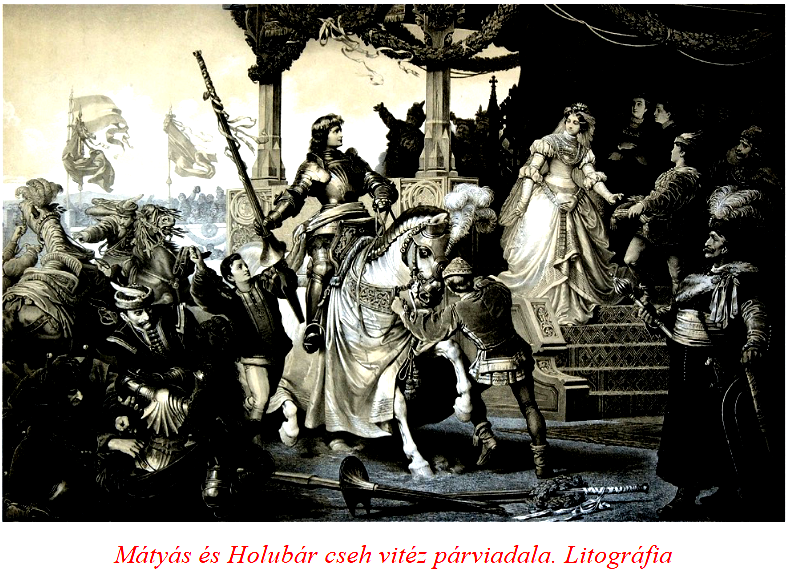
Mátyás' campaign in the Czech Republic is interspersed with numerous anecdotes and historical events. One of them recalls the siege of Chrudin Castle. According to the legend, Mátyás sneaked into the castle wearing a disguise in order to exploit the weak points of the fortress. He was captured, but thanks to his Czech knowledge, he was finally released. (Presumably, this was the first story that served as the basis of the legend about Mátyás in disguise.) The other story was the duel with the mighty Czech warrior Holubár. The clash ended with the victory of Mátyás. It was recorded that Holubár later entered the service of the Hungarian king. On one occasion, György Podjebrád himself challenged Mátyás to a duel. The matter was considered frivolous, because the old, obese Czech ruler could not even sit on his horse.
The death of the Czech king in March 1471 created a conflict for the throne and chaotic conditions in Prague. The events were looked forward to by the Czech, Hungarian, Polish and Austrian lords. It didn't matter who would inherit King György Podjebrád. The Hussite Czechs did not trust the Catholic Mátyas, so the 15-year-old Ulászló, IV. The son of the Polish king Casimir was placed on the Prague throne, although he was also a Catholic.

The Polish IV. Kázmér and the Czech King Ulászló - father and son - decided to settle the score with Matthias. Kázmér left for Silesia with an army of 50,000 people. And Ulaszló marched an army of more than 15,000 people. Mátyás had only 8,000 mercenaries. The seven-fold superiority was frightening, which, however, was balanced by Mátyás's brilliant ability as a general and the military training of the Hungarian mercenaries. Mátyás emptied the villages in the path of the picked-and-sown Polish-Lithuanian-Russian wars, preventing the attackers from supplying food. By the middle of the 1470s, the Black Army had become one of the most powerful forces in Europe, blindly executing all of Matthias's orders. The main Hungarian forces entered the city of Boroszló, while the smaller troops were stationed in the castles of Oppeln, Brieg, Neumarkt, and Ohlan.
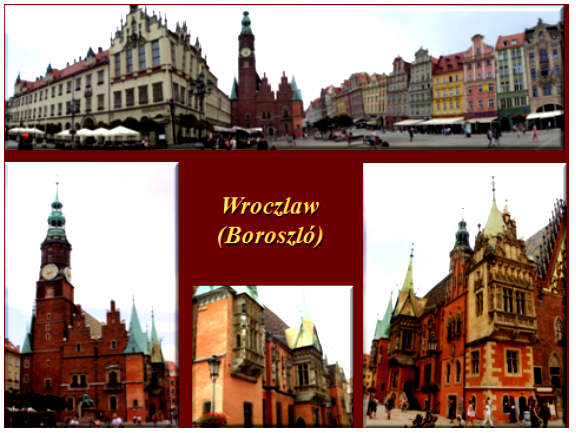

The brilliant victory of Mátyás, in addition to tactics and trained soldiers, is proved by the shameful case when the attackers, weakened by starvation, bought food from the Hungarians. The besiegers were forced to ask for a truce, as they were threatened with total defeat. The whole of Europe spoke of Matthias' brilliant victory, acknowledging the greatness of the Hungarian ruler. During the Silesian campaign, the Hungarian king sent his two most reliable generals, István Szapolyai and Pál Kinizsi, to Poland. The two armies used the light cavalry steppe fighting method, which the Hungarians did not forget even after centuries. They raced across the territory of the enemy country, making resupply impossible. The enemy was crippled in their own country. Mátyás and Ulászló made peace in December 1474, which stipulated, among other things, that they would not go to war with each other for three years.

The peace in 1477 III. It was overturned by Emperor Frederick when he recognized Matthias as Czech king. This rekindled the contradictions, which were put into writing on July 21, 1479, after long negotiations. As a result of the peace concluded in Olmütz, Matthias obtained the Czech throne, but he also became the lord of Silesia, Moravia and Lausitz.
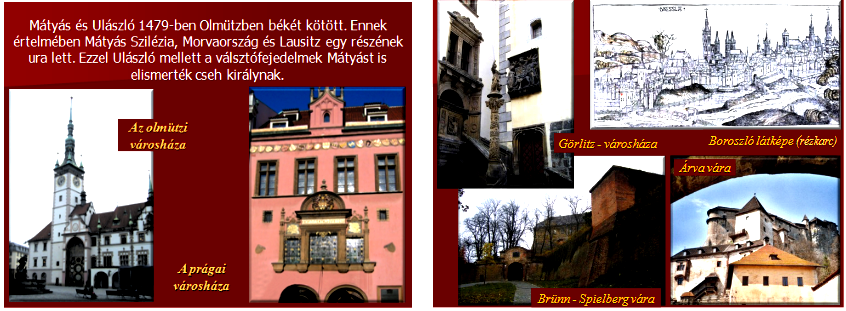

The Hungarian-Czech war, which had been raging for more than a decade, ended in 1479. Mátyás did not achieve his main wish, to completely acquire the Czech throne in Prague. However, there were so many advantages to the skirmishes and the conclusion of peace that Ulászló, the other king of the Prague throne, did not intervene in the Austro-Hungarian war that was about to break out.
The 1471 conspiracy led by János Vitéz
After Mátyás ascended the throne, he convened the parliament almost every year, which was mostly necessary due to the constant lack of money. The king's two most trusted men, János Vitéz and his nephew, Janus Pannonius, also spoke out against excessive taxation. The two high priests were excellent humanist minds. János Vitéz, János Hunyadi's friend, Mátyás' tutor, and Janus Pannonius, the king's contemporary, were elevated to high positions by Mátyás himself. János Vitéz was the archbishop of Esztergom, and Janus Pannonius was the bishop of Pécs. The two high priests and the nobility organized around them set their banner that they would defend Hungary even against Mátyas.
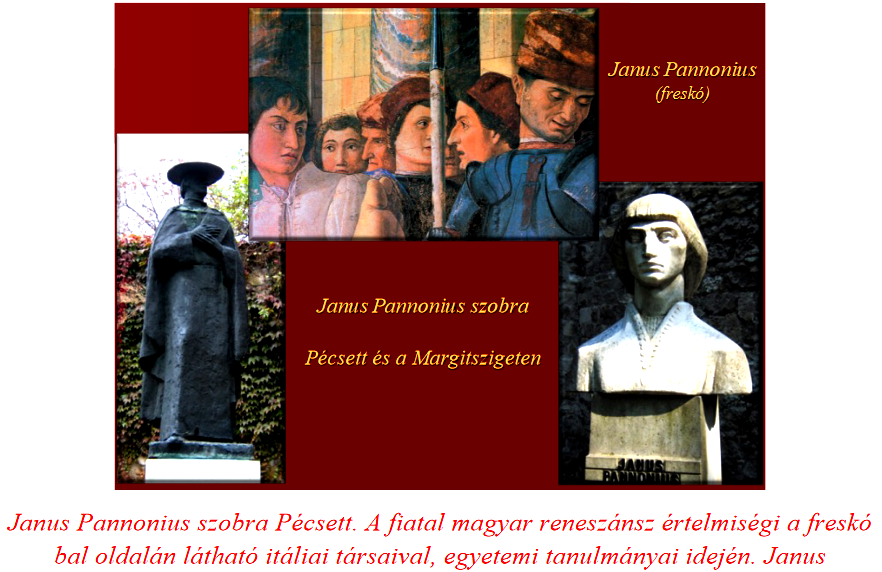

Mátyás's domestic political situation was complicated by the fact that Albert Habsburg's widow, Queen Elizabeth, could never forgive him for succeeding his son László V to the Hungarian throne. He considered Mátyás a stubborn subject, and the entire Polish court was behind him in this belief. The Hungarian conspirators took advantage of this political situation when they offered the Hungarian throne to the Polish prince Kazmér. Mátyás was currently in Silesia, where his spies informed him of the conspiracy. The great tactical king arrived in Buda as if nothing had happened. However, his life was in danger when he walked into the conspirators' ring unprotected and pretending to be innocent.
The plan of the conspirators began by supporting the declaration of war sent by the Polish prince Matthias Kazmér. In October 1471, Kázmér's troops invaded Hungary from the north, in the territory of Sáros county. However, only the Rozgonyi and Perényi families welcomed the Polish troops with friendship, the other lords retreated to their castles and did not dare to act against Mátyás. They did it wisely, because Mátyás' troops had already surrounded Esztergom. It fell into the hands of János Vitéz Mátyás, and the conspiracy collapsed.

The leading figures of the conspirators - János Vitéz and Janus Pannonius - met an inglorious end.
The 64-year-old archbishop of Esztergom, who served the Hunyadi family all his life, died on March 27, 1472, physically and mentally broken, ill, as a prisoner, in his own palace in Esztergom. Janus Pannonius, Mátyás's friend, met his fate while fleeing in Medvevára near Zagreb. died on March 27, 1472, near his birthplace, on the same day as János Vitéz
The year 1471 marked a sharp epochal boundary in Mátyás's 32-year reign. This concerned the order of parliaments, the appointment of barons and high priests, legislation, church politics and military reforms. There were few Hungarian rulers in the history of Hungary who would have appointed as many high priests, ecclesiastical and secular dignitaries, or elevated them from the lowest ranks, as Mátyás Hunyadi. Think of Orbán Nagylucsei, György Handó, Janus Pannonius, János Beckensloer, Tamás Bakócz, or Mihály Országh, who were talented and served the king faithfully. The exception was János Beckensloer, archbishop of Esztergom, who in 1476 III. He fled to Frigyes and took with him a significant part of the enormous wealth of the archbishop's treasury.
The military reform of 1471 deserves special mention. Considering that the effectiveness of the land conscription, the noble uprising, and the lord's banners had dwindled, Mátyás asked for the military contribution in money. And he used the money to develop the mercenary army.
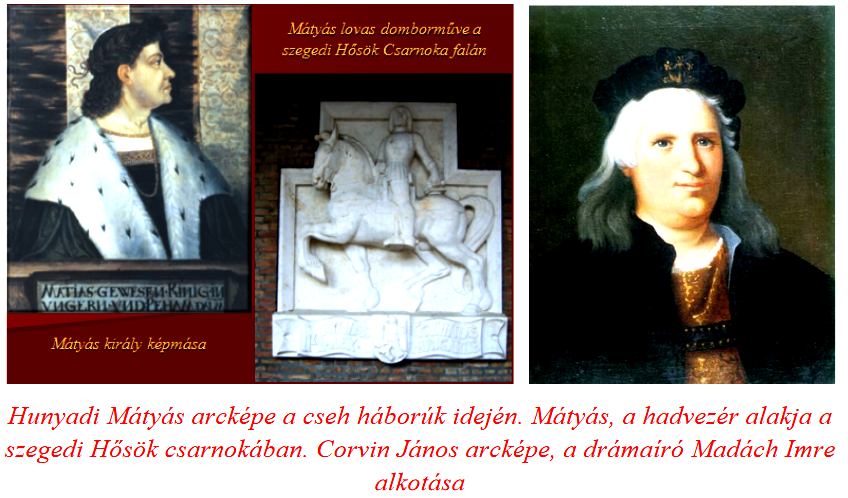
Mátyás was unmarried for more than a decade, but his attraction to women and girls did not diminish even during the Czech wars.
This is how it happened that in 1473, a son was born out of wedlock to a Viennese citizen, Borbála Edelpeck. The son, János Corvin, will play a significant role in the future in the matter of succession. (Nowadays - hopefully in 2022 - it will become clear, after the excavation of the graves of János Corvin and his children in Lepoglava, Croatia, on which DNA line the Hunyadians can be placed. However, the birth of János Corvin proved Mátyás' fertility, which was of fundamental importance due to the infertility of his next wife, Beatrix .)
Mátyás's continued struggle against the Turks
The Hungarian king could not stand idly by as Mehmed the Conqueror got closer and closer to the Hungarian borders. In 1472, the Turks built a huge wooden fortress along the river Száva, Szábács castle. The Hungarians realized, even if late, that the Turks took the defenseless areas in an insidious manner and consolidated their power there. A frightening example of this was provided when in 1474 Ali beg, lord of Szendrő, unexpectedly appeared at Várad, located 300 kilometers to the north, and overran the key episcopal city.

Mátyás knew that in this situation he had to set an example, proving that he was also the master in the Southern Region. He singled out Szábács Castle for this purpose. In February 1476, Frantisek Hag, one of the leaders of the Black Army, surprised and defeated the 15,000-strong army of Ali Bey coming under the castle. However, the final siege of the castle began only after that. Mátyás wanted to see the castle walls up close. They were moving along the channels of the Száva, dressed in disguise, with an oar at the castle wall, when the castle's defenders greeted the boat's passengers with a barrage of arrows. The rower died, Mátyás luckily escaped the adventure. The castle, surrounded by swamps and canals, seemed impossible to capture. However, after a month and a half siege, on February 15, 1476, Mátyás finally took the castle. The important act of war not only proved the talent of the Hunyadi boy, but with the capture of Szábács, the defense system in the south was also strengthened.
Mátyás also had to realize – just like his father at the time – that Western wars would not help, even after the Pope's repeated calls.
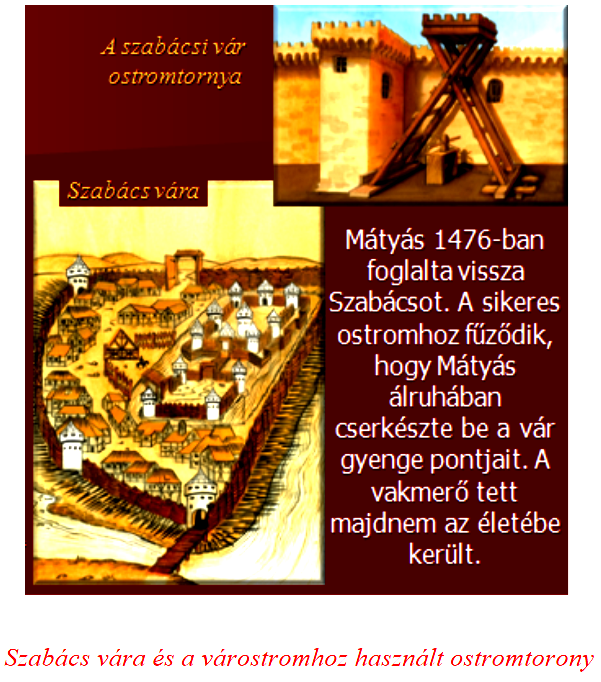
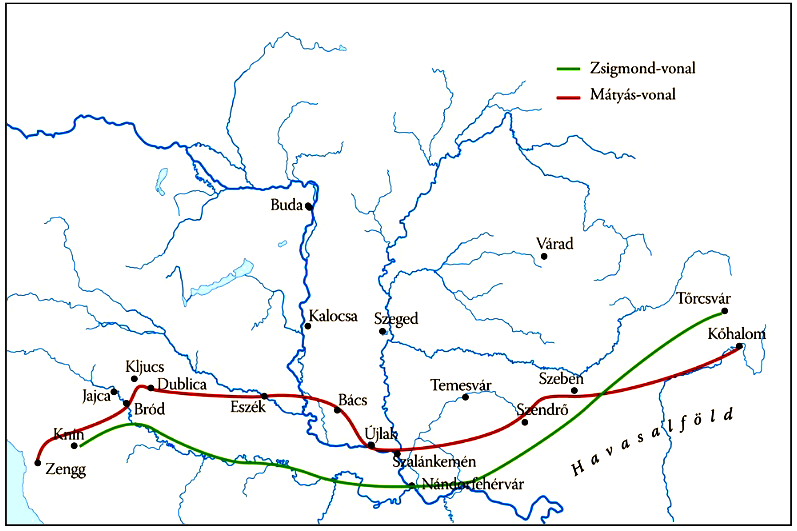

Two Renaissance Popes IV.
Sixtus (1471-1484) and VIII. Ince (1484-1492) while constantly demanding the help of European rulers against the Turks, it became clear that they would not help. Meanwhile, Rome, Florence, Venice, Milan and other Italian cities were enjoying their heyday, and the rich squid towns were abounding in wealth. At that time, the churches, palaces, and town halls were built, which people still marvel at today. During these years, Michelangelo completed the frescoes of the Sistine Chapel in the Vatican, and this is when Leonardo created miracles in painting. It was then that the construction of the Florence Cathedral was completed, and during these years the citizens of Pisa, Verona, Siena, Padua, Venice, Milan, Bologna, and Lucca competed with each other to see which of their cities built the most magnificent churches, palaces, and created the most beautiful sculptures and paintings. Only Venice was occasionally forced to go to war against the Turks, but only when its ports were threatened by the Ottoman threat. They also tried to entrust the protection of the continent to the Hungarians. The fiercest battles took place in Transylvania. Pál Kinizsi penetrated with his army along the Danube as far as Galamboc and Krusevác. However, the greatest success of the campaign was achieved in the battle of Kényérmeze in October 1479. (Kenyérmező is located east of Vajdahunyad, along the Maros, on the border of Szászváros.)
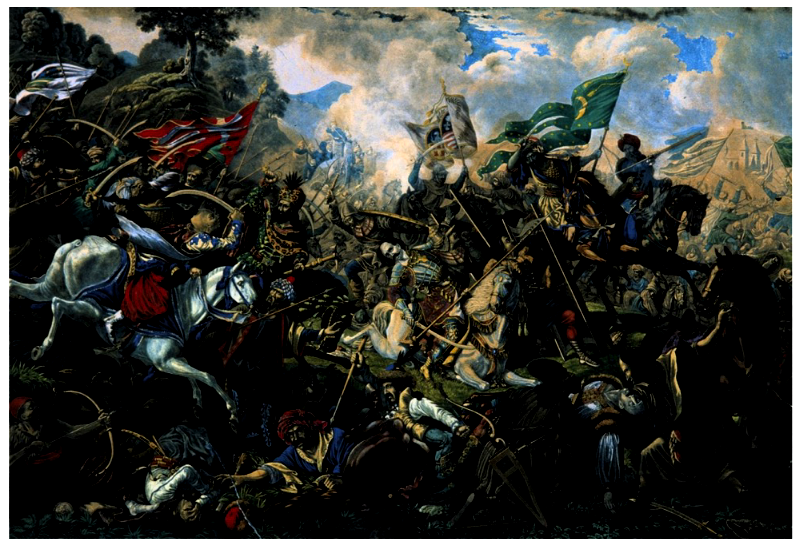

The Turkish army attacking Transylvania was overwhelmingly superior to the Hungarian army led by István Báthori, Voivode of Transylvania and Bishop of Székely.
The Turks had already crushed the advantage of the Székely light cavalry and the Saxon heavy infantry, but help was delayed. The day of the bloody battle had already turned into evening, and Báthori was protected only by the core that persevered to the end, when Pál Kinizsi, the ispan of Temes, arrived at the head of his relieving army. Despite this, the Turks were numerically superior, but the two strong and battle-trained generals cut order in the enemy's ranks. Isa Pasha, the Sandzákbey of Nikápolis, was beheaded by Kinizsi himself. The Hungarians won a brilliant victory, which, according to historians, was the biggest open battle in the history of the Turkish-Hungarian wars between 1456 and 1526. At Kenyérmező, the Hungarians lost 8,000, and the Turks almost 20,000. When Pál Kinizsi lost his life during the siege of Szendrő in 1494, according to his will, he was buried in Nagyvázsony, in the Pauline monastery he founded.
An unusual event in the wars against the Turks, the Otranto campaign, should be mentioned.
Otrantó is located in the southern part of Italy, in the "heel of the boot". In the summer of 1480, Ahmed Pasha attacked this prosperous, rich city with about 130 ships. It should be noted that Otrantó belonged to the kingdom of Matthias's father-in-law, the King of Naples. After the Ottoman armies broke into the city, they staged a terrible bloodbath. More than half of the 22,000 inhabitants were murdered. In addition to the many rich Italian cities, the Pope counted mostly on the Hungarians. Mátyás sent his excellent general, Balázs Magyar, at the head of a mercenary army of about 2,200 people to Otranto. (The Otranto campaign even exceeded the distance of Louis the Great's campaigns in Naples.)

The strategic point of the city was the Minerva spring, which meant water and life for the defenders. Balázs Magyar seized the spring with several attacks, thereby sealing the fate of the Turks. (The spring with abundant water is still known as "Fontana degli Ungheri" the well of the Hungarians.) World Conqueror II. The death of Mehmed, the renewed Hungarian attacks, the hellish heat, and the stumbling supply broke the resistance of the Turks. Just for the sake of order, let's add that the 1,500 fallen Hungarian soldiers and the lack of promised Western support caused Mátyás a significant loss - 50,000 gold war expenses.
Marriage of Mátyás Hunyadi and Beatrix of Aragon
One part of Mátyás' diplomatic activities was that he looked for a wife in the princely courts of Europe. Finally, in 1476, he married Princess Beatrix, the daughter of King Ferdinand of Aragon of Naples. Through his connections, the Hungarian ruler found many allies in Northern Italy, who, like Mátyas, were in hostile relations with Venice.
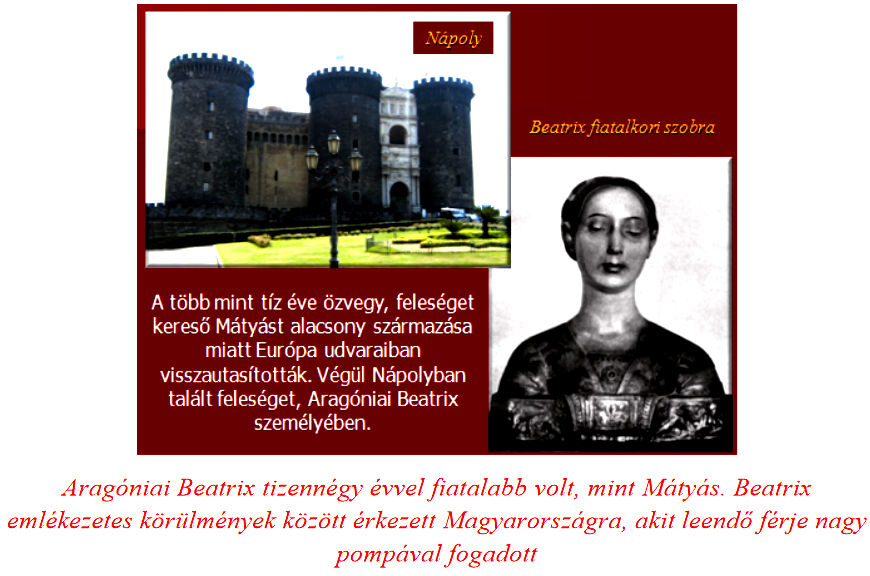
The visiting army first celebrated the beautiful and ambitious Neapolitan princess in Fehérvár, who was escorted by Erzsébet Szilágyi from the border to Fehérvár. Mátyás's head was decorated with the Holy Crown, Beatrix's with the house crown of Fehérvár. The guest army then marched to Buda, where the wedding took place. By this time, the Buda Castle had already been built in its full splendor.

The magnificent wedding took place on December 22, 1476 in the Church of Our Lady in Buda.
The Austrian Wars
After the death of Mehmed the Conqueror in 1481, II. Sultan Bayazid (1481-1512) occupied the throne. The peaceful nature of the ruler created a more predictable policy for Mátyás, since peace was concluded immediately after the sultan ascended the throne. III was less predictable. Frigyes, who immediately attacked the western counties of Hungary as soon as the Hungarian armies marched against the Turks.
At the outbreak of the Austrian war, the III. Austrian lords who rebelled against Frederick played a role and asked Mattyás for support. The war began already in the summer of 1477, when several lords and high priests, including the Archbishop of Salzburg, opened the gates of their castles to Matthias. It is true that Salzburg did not fall into the hands of the Hungarian king, but this conquest towards the west was a historic act.

The wars in Austrian territory were interrupted several times, when the Hungarian troops had to march against the Turks in Transylvania, in the Southern Region, or along the Al-Danube. In addition to occupying many castles and towns, the Hungarian king also conquered the cities of Vienna and Bécsújhely, which III. It was also a significant loss of prestige for Frigyes.
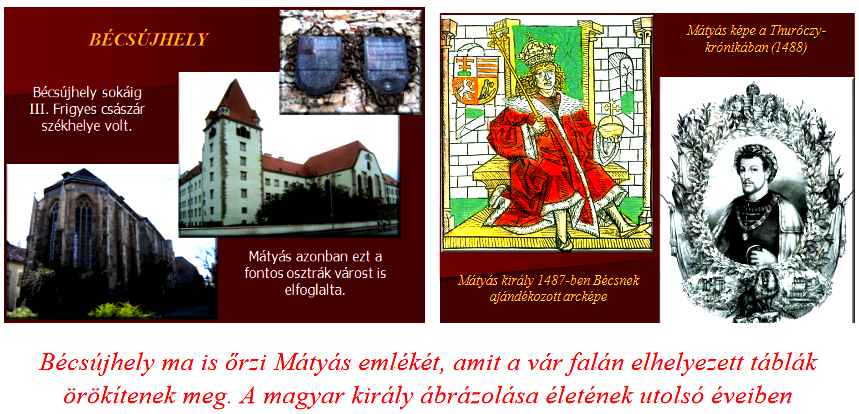
The Austrian wars were often fought by the cunning III.
Frederic put a stop to it with peace agreements, but diplomacy continued at full steam on both sides. Mátyás, for example, also sought contact with the lord of Milan, Ludovico Sforza, and the Swiss cantons in order to surround Frigyes. The situation of the Hungarians was made more difficult by the fact that precisely those rich territories occupied by Mátyás were attacked by frequent Turkish raids. Among them was, for example, Neumarkt, which was then liberated by Jan Haugwitz.
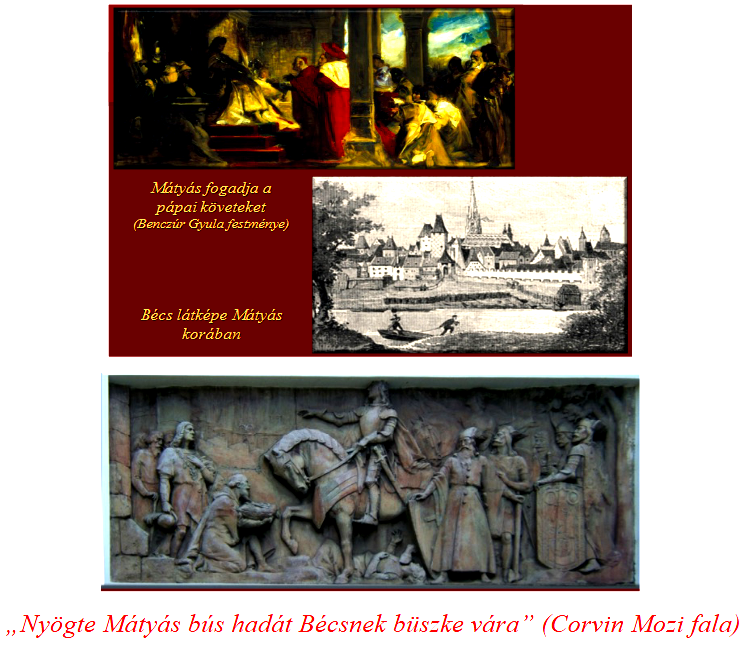
The Renaissance courtyard of Mátyás
The young Mátyás, who received a careful education primarily thanks to János Vitéz, is considered a great figure of the Hungarian Renaissance. He was a worthy debate partner of great scientists not only in history, literature, natural sciences, religious studies and philosophy. He is responsible for the construction of Gothic and Renaissance palaces, castles and churches, the establishment of the first printing press in Hungary (András Hess 1473), the creation of the famous Corvin library and the creation of many other humanist values. It is not true that Beatrix brought Renaissance culture to Hungary, she only enriched it with Italian values.

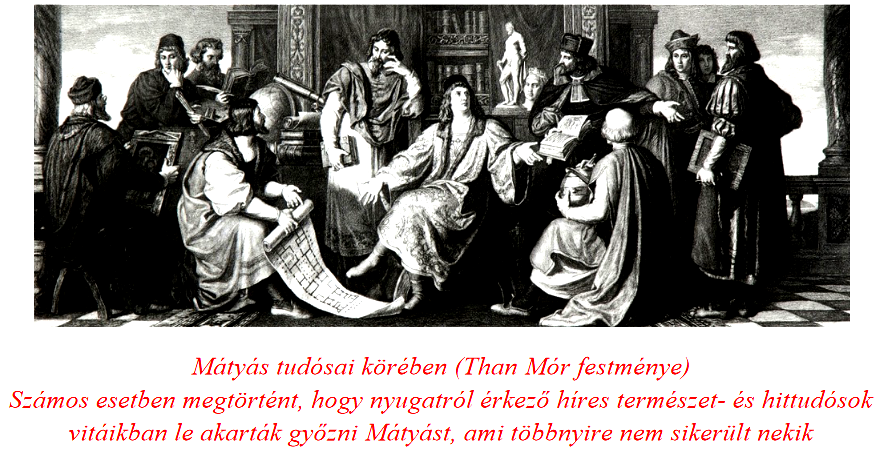
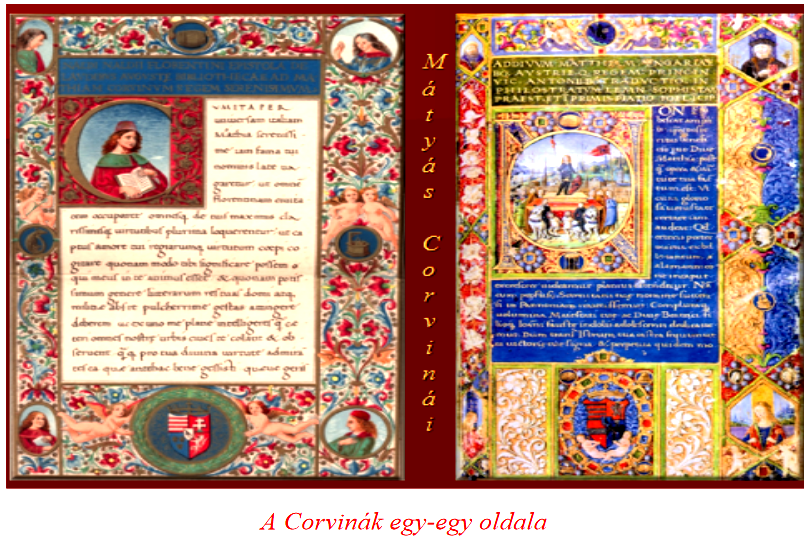

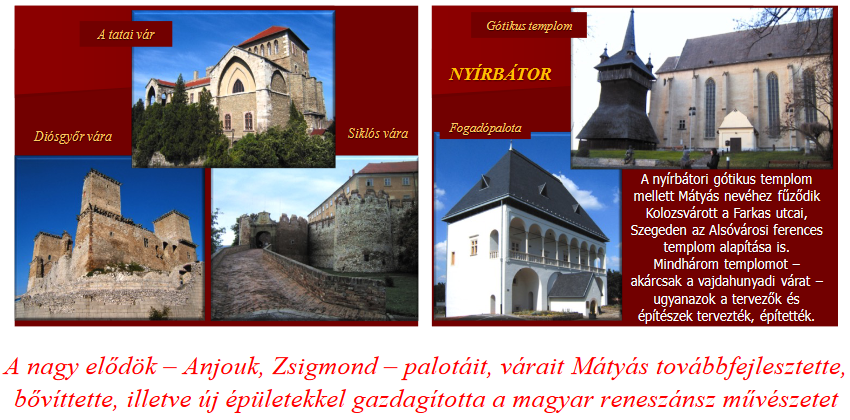
Death of King Matthias
Mátyás Hunyadi spent most of his time in Vienna from 1485. The king and his entourage also enjoyed the Easter holidays of 1490 in the Austrian city. He had been ill before, but tragedy struck on April 4, Palm Sunday. Even in the morning hours, he took part in the fancy ceremony in front of the Burg, where he held a reception for the ambassadors from the countries of Europe. But then he got sick, and they thought it was because of hunger. Queen Beatrix unusually spent a long time in the churches, and therefore the lunch was delayed. The servants gave the king figs, but they were rotten, and this enraged Mátyás. Beatrix, who had just arrived home, behaved strangely. He didn't allow anyone but his own doctor. After two days of sickness, often accompanied by loss of consciousness, on April 6, 1490, the black flag was hoisted on the wall of the Burg. With this, they announced to the country and the world that Mátyás, the great king of the Hungarians, had died. (In connection with Mátyás's death, a number of researchers strongly suspected that the fig was poisoned. Because when Péter, the initiate, offered the starving king a key price of figs, curiously, minutes later, all the dishes of the rich festive lunch were found on Beatrix's orders. Mátyás now does nothing he was able to eat, he screamed in pain. Beatrix forced another unknown liquid into her husband's mouth, saying that it was medicine. From then on, the king lost his ability to speak and went through the agony, his suffering ended after two days.)
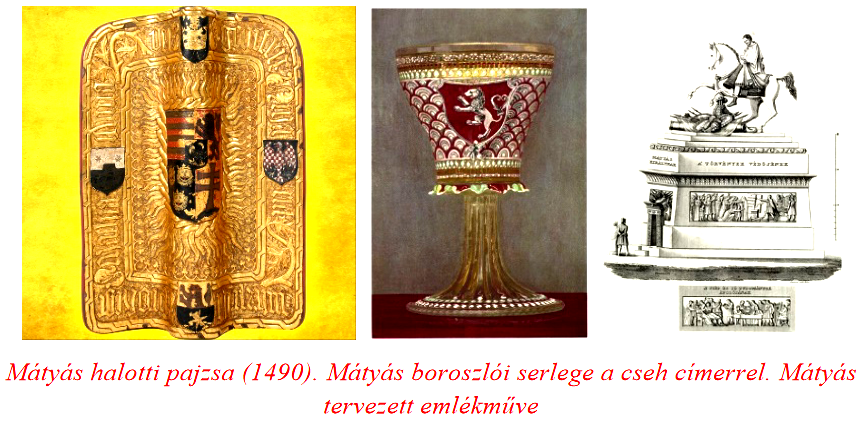
The seated statue of Mátyás can be found in several places. The best known is the work located in the Buda Castle, which can be seen on the street facade of the former Dominican monastery (today the Hilton Hotel). However, the original work can be discovered in the city of Bautzen in Germany. The city came under the rule of Matthias during the Czech wars. The population still preserves and cares for the Mátyás monument above the Castle Gate.
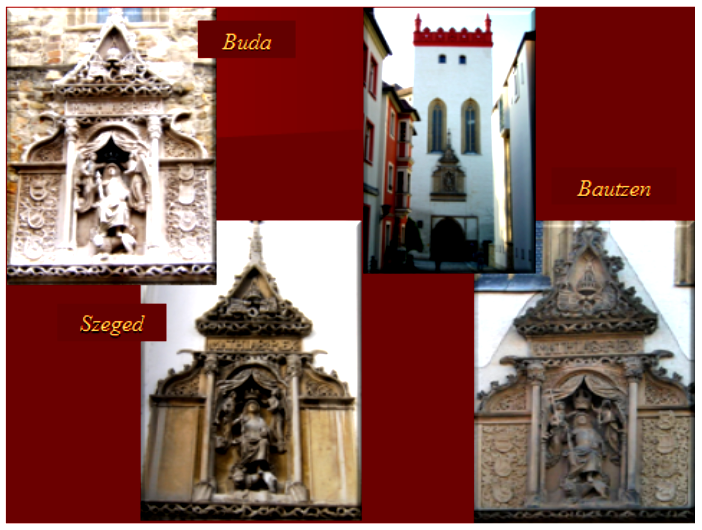

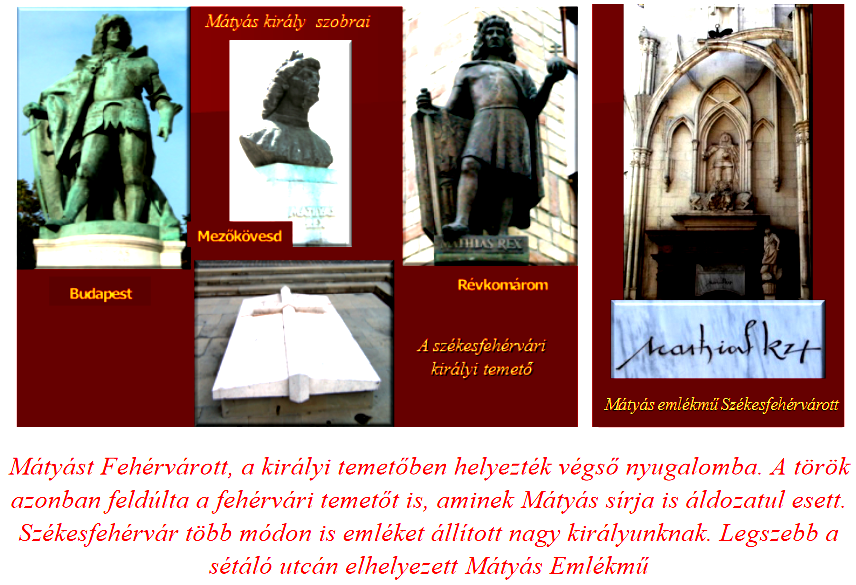
The hero of fairy tales
Looking at the Book of Fairy Tales, we can see that among the great figures of Hungarian history, most fairy tales are related to King Matthias. Mátyás's popularity was based on the persona of the king who walks in disguise and delivers justice to the poor against the rich. Stories often feature the wise court fool, who outsmarts the lords, and the rise of the often pompous nobleman who torments the people, despises manual labor, and pays the price for his stupidity with gold. The figure of the brave Mátyás, who is invincible in duels and battles, appears in a good number of fables.
The best-known legends are brought to life by statues and monuments all over the country. Such is the figure of the king seen in Sajógömör (now Slovakia), holding a hoe. The work is based on the fable King Matthias and the vineyard workers, when the king teaches a lesson to the gentlemen who love wine but despise the vineyard workers. The decorative fountain of the Buda Castle depicts a hunting scene, which served as the basis for many stories. The statue preserves in Létavértes the scene when Pál Kinizsi, then still a miller's apprentice, serves the drink to the king on a millstone tray.

On the wall of the dining room of the Pannonhalmi Abbey, you can see the allegorical fresco, the central figure of which is King Matthias sitting on his throne, whom the painter depicted among the greats of Hungarian history.

Author: Ferenc Bánhegyi
(Cover image: the King Matthias monument in Cluj. Source: euroastra)
The parts of the series published so far can be read here: 1., 2., 3., 4., 5., 6., 7., 8., 9., 10., 11., 12., 13., 14., 15., 16., 17., 18., 19., 20., 21., 22., 23., 24,, 25., 26., 27., 28., 29/1., 29/2., 30., 31., 32.












